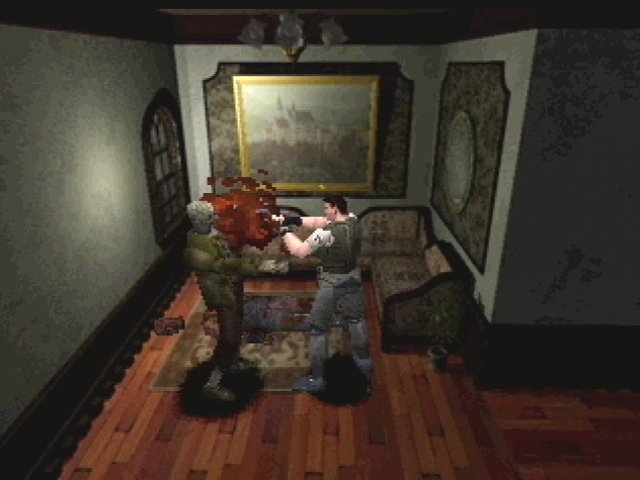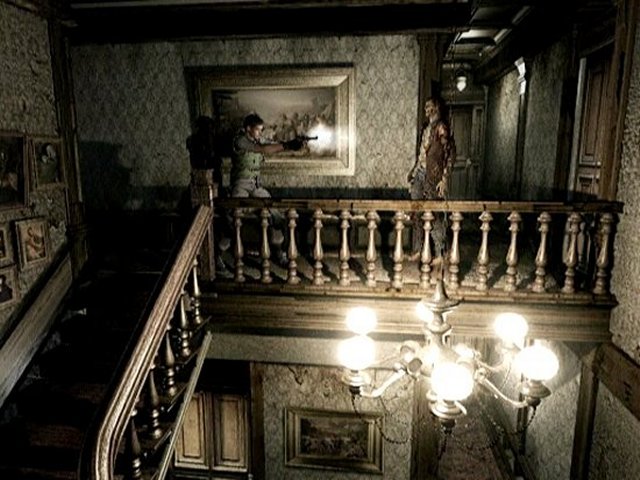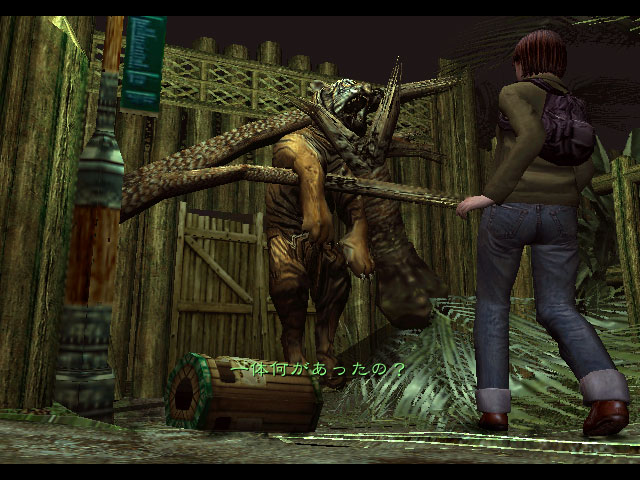Dear Reader,
With “Resident Evil: Revelations” on the verge of release (and receiving rave early reviews), not to mention “Operation Raccoon City” looming in March, it’s as good a time as any to take a look back the history of one of gaming’s biggest franchises.

Rather than just list off every game in the series (you can check Wikipedia for that), I’ll point out the most memorable “Resident Evil” releases; from its grandest successes to its most embarrassing failures.
Hit the jump and let’s have some fun.
Success: “Resident Evil” (1996/Playstation)

Ah, there’s nothing like the classics. The original RE wasn’t the very first “survival horror” game, but it was probably the most important. The basics of the genre were most clearly established here: incredibly sparse resources, horrific enemies, disorienting controls, random pop-outs. While most games of the time (and now) conferred godlike status on the player, “Evil” sought to make you powerless and afraid. Later classics like “Silent Hill” and “Eternal Darkness” would continue to play with the formula, but it was “Resident Evil” that first brought survival horror into the spotlight.
Success: “Resident Evil 3: Nemesis” (1999/Playstation)
I know some of you are going to cry “bloody murder” at me for skipping “Resident Evil 2,” but in the scheme of things, “Nemesis” is a much more important title. Although RE2 was a great game, RE3 introduced more innovative features: a 180-degree-turn button, the “Mercenaries” minigame, ammo creation, and of course, the Nemesis. Universally regarded as one of gaming’s greatest bosses, Nemesis’ relentless pursuit of the player throughout the story was responsible for gallons of palm sweat distributed onto controllers around the world. Although the horror market was a lot more crowded in 99, RE3 proved that “Resident Evil” was still top dog.
Failure: “Resident Evil: Survivor” (2000/Playstation)

A first-person RE title doesn’t sound like a bad idea, but boy did it not work out when they first gave it a try. From wonky controls to uninspired, repetitive gameplay and horrendous graphics, “Survivor” failed to elicit fear or even any sense of fun from the player. Although the blow was softened by the release of the excellent “Code Veronica” that same year, “Survivor” was the first real stinker that the “Resident Evil” franchise produced. Unfortunately, it would not be the last.
Failure: “Resident Evil Gaiden” (2001/Game Boy Color)
The name should have tipped you off that something was wrong. “Gaiden?” Huh? The player wandered around from a Link’s-eye view until zombies attacked, whereupon they were awkwardly slammed into first-person to dispatch them with a stupid little “stop the reticle” mini-game. “Gaiden” couldn’t hope to be scary, nor could it compete with the shooting action available on home consoles, so it was forced to lean into an element that has always been “Resident Evil’s” weak spot: puzzles. Blegh. The franchise would later produce quality handheld content, but “Gaiden” proved they weren’t there yet.
Success: “Resident Evil” (2002/Gamecube)

Easily one of the best remakes in gaming history, “Resident Evil” for the Gamecube featured new graphics, sound, cutscenes, and even some new environments and gameplay features. At its core, though, it was still the classic survival horror experience that launched a thousand survival horror experiences. The most amazing thing about the “Resident Evil” remake was that in spite of technically being a game that many had already played, it was still scarier than most of its competition. It served as a potent reminder of the franchise’s strength on its best days.
Failure: “Resident Evil Outbreak File #2” (2004/Playstation 2)

The original “Outbreak” wasn’t great, but it also wasn’t bad enough to earn on spot on this list; its cheap cash-in sequel, on the other hand, was. “File #2,” like its older brother, was an attempt to introduce four-player cooperative combat to the “Resident Evil” franchise (something “Operation Raccoon City” will try again in March), but its inexplicable decision to exclude voice chat again sank those efforts. How is anyone supposed to cooperate with no real means of in-game communication? Add that to bad A.I, no story to speak of, and a sense of ennui from having played “Outbreak” already, and the result was a good idea destroyed by an unwillingness to follow through.
Success: “Resident Evil 4” (2005/Gamecube)
Simply put, “Resident Evil 4” is one of the five or ten best games ever made. It unshackled the franchise from pre-rendered environments and tank controls, and that alone got people excited, but it didn’t stop there. The campaign was a masterpiece of pacing and set piece construction; there wasn’t a dull level, or a mediocre boss fight anywhere to be found. Even before the opening credits rolled, RE4 set the tone with one of the most frightening set pieces in gaming: Leon Kennedy alone and outnumbered in a European town, with very little ammo, no cover, no escape route, and no mission objective. The player had to endure wave after wave of enemies, with no concept of how much more was coming; there wasn’t even a timer. When the attack finally stopped, and Kennedy emerged visibly shaken from his makeshift shelter, RE4 cockily slammed its title onto the screen. The message was clear: “we’re just gettin’ warmed up.”
Success: “Resident Evil: The Darkside Chronicles” (2009/Wii)

Although not the first RE on-rails shooter, “Darkside Chronicles” was almost inarguably the best, thanks to a clearer HUD, auto-scaling difficulty, and better level design. It was no one’s idea of frightening, but it controlled well and was fun, especially with two people. First person RE games have a reputation for being cheap and clunky, and they absolutely deserve that reputation, but “Chronicles” provided a pleasant, diet-soda shot of the “Resident Evil” formula.
Success: “Resident Evil 5” (2009/Xbox 360 and PS3)
We all knew it was coming: the “Resident Evil” game that would finally shout “aw, go f@$k yourself suspense” and embrace action head-on. “Resident Evil 5” was that game: broad daylight, big guns, hot chicks, car chases. Despite some bogus accusations of racism (no one complained about gunning down 90% Caucasian zombies for over a decade), RE5 was a fast, furious, sweat-drenched beast. “Resident Evil” games are always trying to implement co-op, often with mixed results, but here everything clicked beautifully. I’d hate to see the franchise abandon atmospheric horror permanently, but as a diversion, RE5 was a refreshing change of pace.
Failure: “Resident Evil The Mercenaries 3D” (2011/3DS)

2010 was the first year to not feature a new “Resident Evil” in sixteen years, so it was incredibly frustrating when 2011 yielded only “Resident Evil The Mercenaries 3D.” The problem with “Mercenaries” actually isn’t that it was bad, but that it was overpriced. Capcom compiled the “Mercenaries” modes from RE4 and RE5, added absolutely zero new maps or enemies, and slammed a $40 price tag on for your trouble (you could probably buy RE4 and RE5 for that). And while it introduced skill trees, they were nothing particularly special, and the gameplay quickly sank into a repetitive grind. “Mercenaries” would have been an amusing game at half the price, but for full retail, there should have been more.
_AA
humans are disgusting; i opened one up once, i almost barfed.

18 Comments
Very surprised and happy that you listed RE5 as a success. Maybe we can be friends after all…
I knew we’d find some common ground somewhere, Mecha.
It certainly features some of the best dramatic rock punching ever seen in video games.
wait you mean success in sales? oh that makes sense cause if it was in terms of gameplay and horror this list would be BS (minus re1) also you forgot RE zero
I didn’t forget anything, I left RE0 off deliberately. Snooze-fest.
Sidebar: the list is not sales, it’s gameplay. Horror or a lack thereof isn’t necessarily a deal-breaker, especially in cases like RE5 where being scary was clearly never the goal. But if the game WANTED to be scary and wasn’t (as in Survivor), then I penalized it.
games like re4 tried to be scary a lil but overall its just a action game not horror and what do you mean zero was a snoozefest? it was great
I definitely agree that RE4 is not horror scary, but I do think it’s incredibly tense and unnerving. It’s like how “Aliens” isn’t scary like “Alien,” but is still really good.
As for Zero, I thought the co-op sapped the fear out of it, and since it WAS trying to be scary, it just ruined it for me. But that’s me.
“tense and unnerving” what Re4 did you play?!
I know it’s not “horror” scary, but I don’t think it was trying to be. I found it to be an incredibly tense and exciting gaming experience.
i found it a stupid TPS (which is not what i wanted when i bought it new -__-)
…But…why? What was wrong with it? As far as I can tell, that game is near PERFECT.
i bought it thinking it was a horror game…since it was not i was disappointed! >:(
Okay, that I get. But on its own terms, the game really is quite masterful.
masterful no but a good game yes
🙂
Where the f*c* is RE 2? 😀 It’s easily the best in the series
Resident Evil Outbreak File1 an 2 are so entirely underrated. Most the people that thrash it tend to hate the old style, never got to play it online, or whine about the bots which tend to outlive the terrible player whining about them (although the AI isn’t great it’s better than RE5’s AI which just follows, stays, and does the few scripted things it has to do for the player to complete the game). I agree the lack of communication when you want to play with friends is annoying online and that it should have been an option, but the voice commands worked in their own campy sort of way and gave the game personality. You felt more like you were playing with the survivors in the game rather than somebody over the internet, and it also made it where someone couldn’t just tell you where every item was and how to solve every puzzle in the game (unless they did it in lobby… in which case good luck remembering). It’s kind of similar Demon’s souls chat system, only with more personality and less difficulty getting into the same game as your friends.